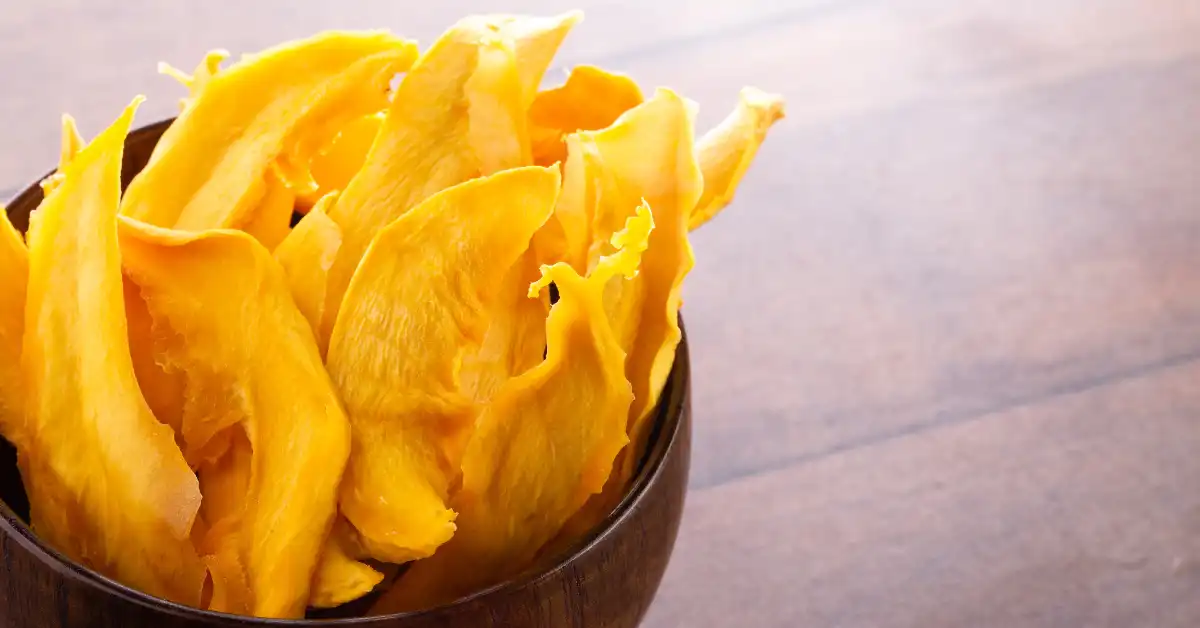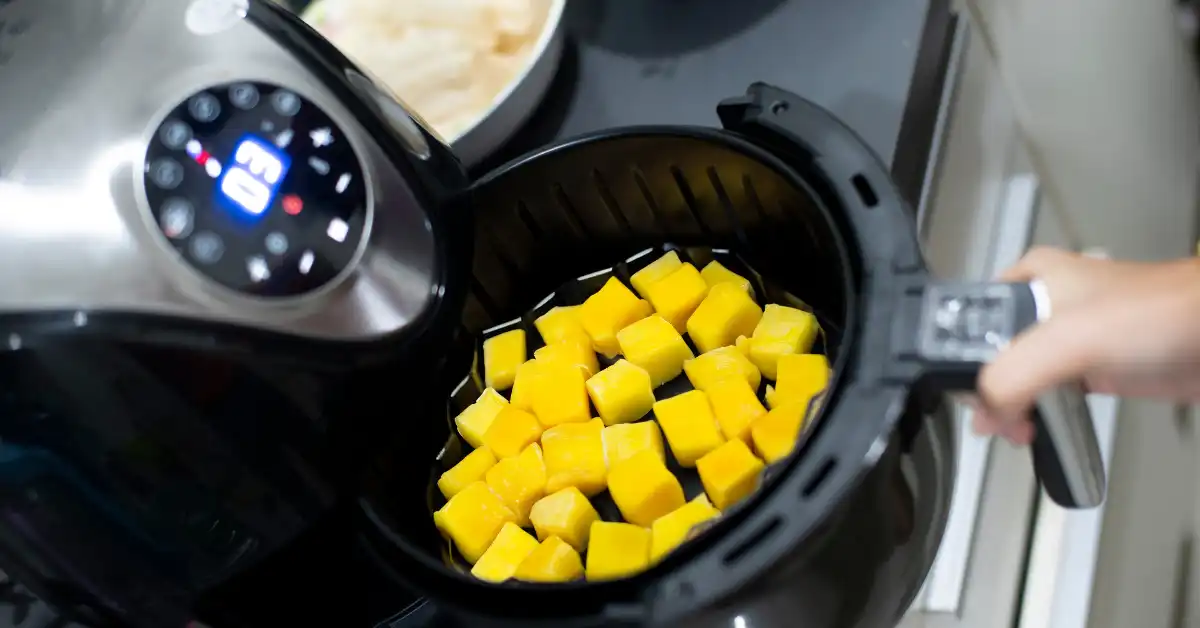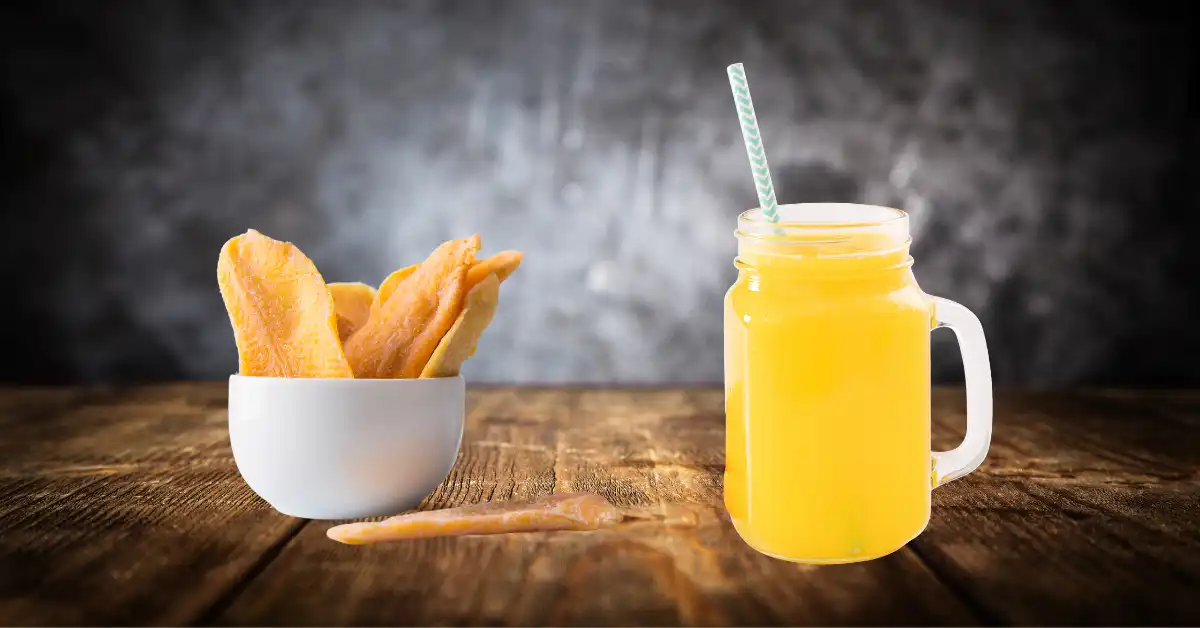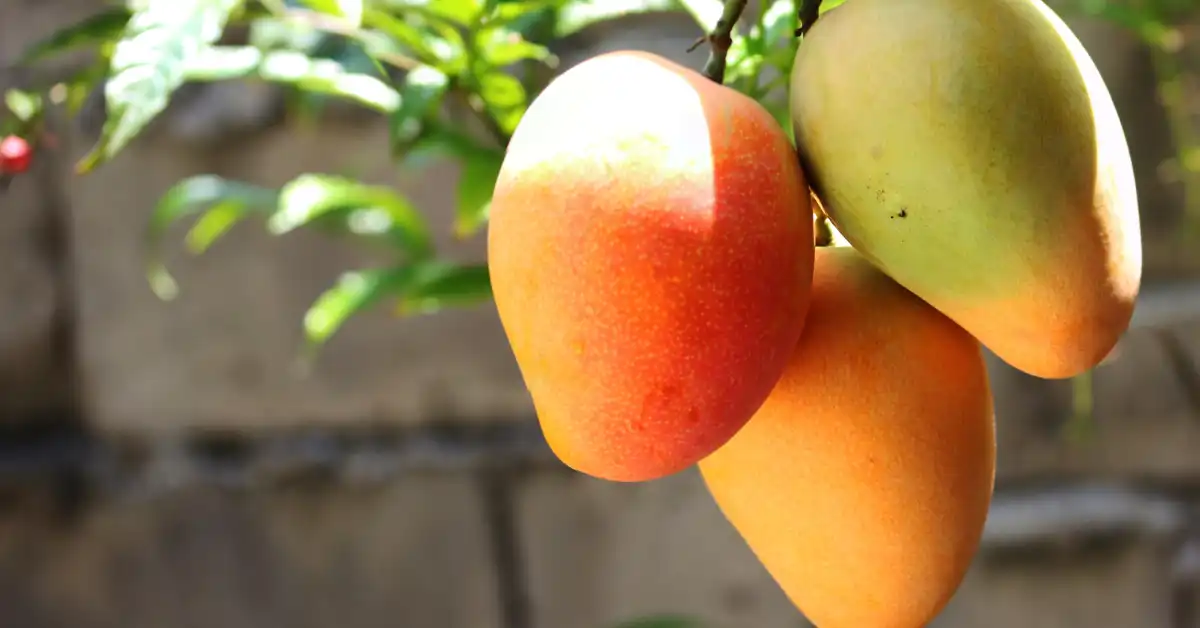In this guide, we’ll explore how to dehydrate mangoes in an air fryer using three easy methods that are perfect for everyone, from beginners to experienced cooks. First, we’ll look at the Thin Slices Method, which offers the advantage of quick dehydration times, allowing you to enjoy your tasty treat sooner. Next, we’ll discuss the Chunky Cubes Method, which is great for those who prefer a meatier texture to snack on. And for those who love a bit of extra zest, the Spiced Mango Strips Method will be a delight, adding an exotic flavor twist to your dried mangoes. Each method is simple and designed to enhance your snack-time with deliciously dehydrated mangoes right out of your air fryer.
Table Of Content
How to Dehydrate Mangoes in Air Fryer? Sun-Kissed Sweetness
Before jumping into our first adventure with dehydrating mangoes using the Thin Slices Method, it’s crucial to understand why we’re opting for an air fryer over other methods. Dehydrating mangoes, or any fruit for that matter, can be done in various ways, but the air fryer stands out for its efficiency, ease, and the unique benefits it offers. The methods provided in this guide, starting with the thin slices and moving through chunky cubes and spiced strips, are designed to ensure you get the best out of your mangoes, with a focus on simplicity and taste. But before we start, it’s important to highlight why using an air fryer is such a game-changer for dehydrating mangoes compared to other appliances.
Benefits of Dehydrating Mangoes in an Air Fryer

- Quick and Efficient: The air fryer dramatically reduces dehydration time, allowing you to enjoy your dried mangoes much sooner than traditional methods.
- Consistent Results: With the even air circulation, each piece of mango dries uniformly, ensuring every bite is perfectly dehydrated.
- Nutrient Preservation: Dehydrating at a lower temperature, as done in an air fryer, helps in preserving the vitamins and minerals in mangoes better than higher-temperature methods.
- Energy-Saving: Compared to a conventional oven, an air fryer is more energy-efficient, making it not only a healthier choice for you but also for the planet.
- Convenience: Its set-and-forget feature means you don’t have to stand and monitor the process, freeing you to do other tasks.
Step-by-Step Guide to Dehydrating Mangoes Using the Thin Slices Method

Getting ready to dehydrate mangoes with your air fryer opens up a flavorful, healthful snacking option that’s both easy and quick to prepare. The Thin Slices Method is especially appealing for those looking for a crispy, chip-like texture. The key to success here lies in the preparation of the mangoes, so let’s walk through this process together, ensuring your dried mango treats turn out absolutely perfect.
Preparing Your Mangoes for Dehydration
- Selecting the Right Mangoes: Look for ripe yet firm mangoes. The perfect ripeness ensures a sweet flavor, while firmness makes them easier to slice thinly and evenly.
- Washing and Peeling: Clean your mangoes under running water to remove any surface dirt or residues. Then, using a sharp peeler or paring knife, gently peel off the skin.
- The Perfect Cut: For the Thin Slices Method, it’s imperative to slice your mangoes as uniformly as possible, aiming for about 1/8 to 1/4 inch in thickness. Thin, even slices ensure that the mangoes will dehydrate uniformly, resulting in a consistent texture and drying time. Use a sharp knife and take your time with this step to get the best results.
- Prepping the Air Fryer: Lightly grease your air fryer rack or use a perforated parchment liner designed for air fryers. This prevents sticking and allows for optimal air flow around each slice.
Dehydrating Your Mango Slices
Now that your mango slices are prepped and ready, it’s time to move on to the dehydration process itself. Here’s a step-by-step guide to getting those slices perfectly dried:
- Lay Out the Slices: Arrange your mango slices in a single layer on the air fryer rack, ensuring none of the slices are overlapping. This helps in achieving an even dehydration process as air can circulate freely around each slice.
- Temperature and Time: Set your air fryer to 135°F (57°C), which is the ideal temperature for dehydrating fruits while preserving their vitamins and minerals. Dehydrate the mango slices for about 2-3 hours. However, start checking at the 2-hour mark since air fryer models can vary in performance.
- Flip Halfway Through: To ensure even drying, open the air fryer halfway through the dehydration process and flip each mango slice. This is a good practice to ensure that both sides dry evenly.
- Cool Down: Once the slices have achieved a crisp, leather-like texture, remove them from the air fryer and allow them to cool at room temperature. Cooling is an important step as it finalizes the drying process.
- Storage: Store your dehydrated mango slices in an airtight container to keep them fresh and crispy. If properly dried and stored, they can last for several months, though I doubt they’ll remain uneaten for that long!
Effortless Dehydration with the Chunky Cubes Method

Now that you’ve mastered the Thin Slices Method, it’s time to roll up our sleeves for the Chunky Cubes Method. This approach is ideal for those who prefer a more substantial bite to their dried mangoes, offering a unique texture and an intensified flavor experience. The key difference here lies in the preparation of the mangoes, specifically in how they are cut. As we embark on this new adventure together, I’ll guide you through each step, ensuring your chunky mango cubes turn out perfectly dehydrated.
Preparing Mangoes for Chunky Cubes Dehydration
- Selecting Mangoes: Aim for mangoes that are ripe but still hold firmness. This consistency is crucial for cutting into cubes and maintaining shape throughout the dehydration process.
- Washing and Peeling: Gently wash the mangoes under running water. Once clean, peel off the skin using a reliable peeler or a sharp knife.
- Cutting into Cubes: Here’s where the Chunky Cubes Method diverges from the thin slices. Cut the mango into two halves, avoiding the pit. Then, slice the halves into approximately ½-inch thick strips, which you’ll dice into cubes. This specific cut enhances the texture and allows for a delightful bite-sized snack.
- Prepping the Air Fryer: Just like before, lightly oil the air fryer rack or use a perforated parchment liner to prevent the mango cubes from sticking and to promote optimal airflow.
Dehydrating Your Mango Cubes
With your mango cubes prepped, we’re now ready to move on to the dehydration process. This method is similar to the previous one but adjusted for chunky cubes.
- Laying Out the Cubes: Arrange the mango cubes on the air fryer rack in a single layer, ensuring they’re not touching. Space between cubes is crucial for even air circulation and dehydration.
- Temperature and Time: Set the air fryer to 135°F (57°C) again, perfect for preserving those essential nutrients. Dehydrate the mango cubes for about 3-4 hours. Given their size, they may require a bit more time than slices, so check on them after 3 hours.
- Shaking Instead of Flipping: Given their shape, flipping each cube individually might be cumbersome. Instead, gently shake the basket or stir the cubes halfway through the process to promote even dehydration on all sides.
- Cooling Down: Once the mango cubes have reached your desired texture, remove them from the air fryer and allow them to cool. This step is not to be overlooked as it completes the dehydration process.
- Storage: Transfer the cooled mango cubes into an airtight container. They’re now ready to be enjoyed immediately or stored for the long haul, maintaining their freshness and flavor.
Innovative Dehydration Technique: Spiced Mango Strips Method

Diving into the art of dehydrating mangoes brings us to a fascinating variation – the Spiced Mango Strips Method. This unique approach allows us to infuse mango strips with delightful spices, elevating their taste to a whole new level of deliciousness. Ideal for snack enthusiasts looking to add a kick to their treats, this method combines the joy of crispy dehydrated mangoes with the warmth of your favorite spices. Below, I will walk you through the steps, making it a straightforward and enjoyable process even for beginners.
Preparing Mangoes for Spiced Strips Dehydration
- Selecting Mangoes: Look for mangoes that are at the perfect crossroads of ripeness and firmness, same to same with the Thin Slices Method
- Washing and Peeling: Proceed with the initial steps as you would for the thin slices or chunks, ensuring your mangoes are clean and peeled.
- Cutting into Strips: The signature cut for this method involves slicing the mango into strips, about 1/4 to 1/2 inch in width. This size is optimal for absorbing the spices and ensuring a chewy yet tender texture post-dehydration.
- Adding Flavours: This is where the Spiced Mango Strips Method stands out. Choose your preferred spices – from classic choices like cinnamon or chili powder to more adventurous options like turmeric or cardamom. Prepare a mixture of these spices in a bowl. Lightly brush each mango strip with a thin coat of oil (coconut or olive work well) and then gently toss the strips in the spice mixture, making sure they are evenly coated.
Considerations for Spiced Mango Strips
- Spice Intensity: Adjust the quantity of spices based on your preference for heat or flavor intensity. Start with lesser amounts; you can always add more per your taste.
- Even Coating: Ensure each strip is uniformly coated with both oil and spices. An even coating guarantees a consistent flavor experience in every bite.
- Airflow is Key: When arranging the strips in the air fryer, leave enough space between them to allow for proper airflow. This ensures even dehydration and optimal spice infusion.
Step-by-Step Guide to Dehydrating Spiced Mango Strips
- Arrange the Strips: Place your spice-coated mango strips on the air fryer rack, spaced out to avoid overlap. Optimal spacing is crucial for uniform drying.
- Temperature and Time Setting: Set your air fryer to 135°F (57°C), the ideal temperature that balances efficient dehydration with preservation of the mango’s natural flavors and added spices. Expect the dehydration process to take approximately 2-4 hours, but start checking at the 2-hour mark due to variances in air fryer performance.
- Mid-Process Check: Halfway through the dehydration, carefully open the air fryer to check on the progress. This is an excellent time to rotate the strips if necessary to ensure even drying.
- Cooling Period: Once the mango strips reach the desired crispness, remove them from the air fryer and allow them to cool at room temperature. This not only eases handling but also enhances the texture, making the strips chewier.
- Storage Solutions: To maintain their crispness and flavor, store the cooled, spiced mango strips in an airtight container. They are now ready to serve as a delightful snack or a creative garnish on your favorite dishes.
How Long to Dehydrate Mangoes In Air Fryer?
Dehydrating mangoes using an air fryer is a straightforward process that varies slightly depending on the cut of the mango. For Thin Slices, the ideal dehydrating time is around 2-3 hours at 135°F (57°C). This time frame ensures that the slices are perfectly dry while preserving their natural sweetness. Chunky Cubes, given their larger size, require a bit more patience, typically about 3-4 hours under the same temperature settings. It’s essential to shake the basket halfway through to promote even drying. For those who prefer a burst of flavor, Spiced Mango Strips also take about 2-4 hours to dehydrate. However, the exact time might vary based on the air fryer model and the desired crispiness level. Remember, the key to perfect dehydrated mangoes lies in regularly checking the texture and adjusting the time accordingly.
Health Benefits of Vitamins A, C, and K in Dehydrated Mangoes
Dehydrated mangoes are not just tasty; they’re packed with important vitamins like A, C, and K, making them a super healthy snack. Vitamin A is great for your eyes and skin. It helps you see better in the dark and keeps your skin healthy. Vitamin C is a superhero for your body. It helps heal cuts and wounds, and keeps your gums healthy. Plus, it makes it easier for your body to fight off germs. Vitamin K is important because it helps your blood clot. This means if you get a cut, your blood will thicken and stop the bleeding faster. Eating dehydrated mangoes can give you these vitamins and help your body stay strong and healthy.
Mangoes: A Great Source of Potassium and Magnesium
Mangoes are not just sweet and juicy; they are also full of good stuff like potassium and magnesium. These are minerals your body needs to work well. Potassium is like a power charger for your heart and muscles. It helps them do their job of keeping you moving and grooving. Magnesium is also important because it helps your body make energy, and keeps your bones strong. Eating mangoes can help you get these minerals easily and keep you feeling great.
Refreshing Drink with Reconstituted Dried Mangoes

Creating a refreshing drink with reconstituted dried mangoes is a simple and delightful way to enjoy the flavors of mango all year round. This easy process turns dried mangoes back into a juicy form, making them perfect for a hydrating beverage. Here’s how you can do it in easy-to-follow steps:
- Reconstituting Dried Mangoes: Begin by placing your dried mango slices in a bowl. Cover them with warm water and let them sit for about 30 minutes, or until they become soft and plump. This process rehydrates the mangoes, restoring some of their original texture and juiciness.
- Preparing the Drink: Once the mangoes are rehydrated, remove them from the water and blend them into a smooth puree. For a single serving, a handful of reconstituted mango slices is usually enough. You can add a bit of the soaking water to achieve the desired consistency.
- Customizing Your Drink: To add a twist to your mango drink, consider mixing in other ingredients like a dash of lime juice, some honey for sweetness, or even a pinch of chili powder for a spicy kick. Blend these in with your mango puree.
- Serving: Pour your mango drink into a glass, add some ice cubes if you prefer it chilled, and enjoy! This mango beverage is not only tasty but also packed with nutrients, making it a healthy choice for staying refreshed.
Conclusion
In conclusion, learning how to dehydrate mangoes in an air fryer is a simple, nutritious way to enjoy this tropical fruit all year round. We’ve explored three different methods – the Thin Slices Method, the Chunky Cubes Method, and the Spiced Mango Strips Method, each offering a unique texture and flavor profile. Whether you prefer your mangoes lightly spiced or in juicy, chewy slices, the air fryer provides an efficient and easy-to-follow process for dehydration. Not only do these methods preserve the mangoes’ essential nutrients like vitamins A, C, and K, as well as minerals like potassium and magnesium, but they also offer a customizable snack that caters to a variety of taste preferences. Remember, experimenting with different thicknesses, spice combinations, and hydration levels can lead to discovering your perfect mango treat. Now, with these techniques in hand, you’re all set to ensure your mango cravings are satisfied healthily and deliciously year-round.

